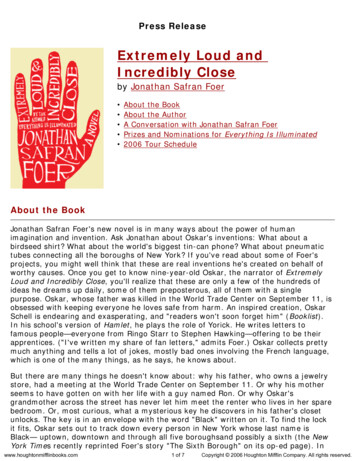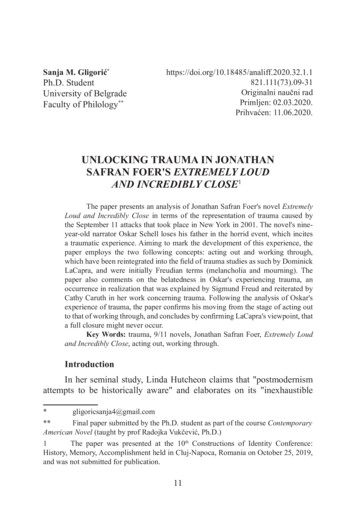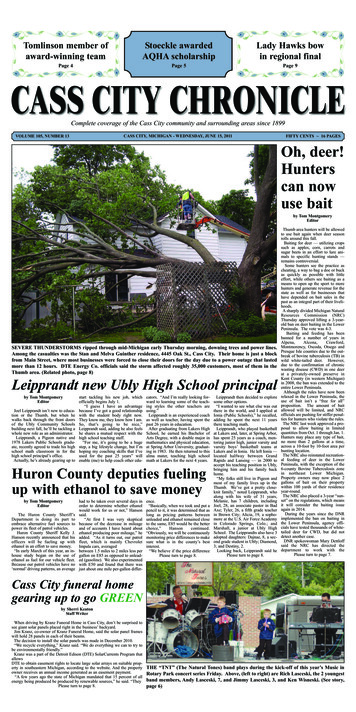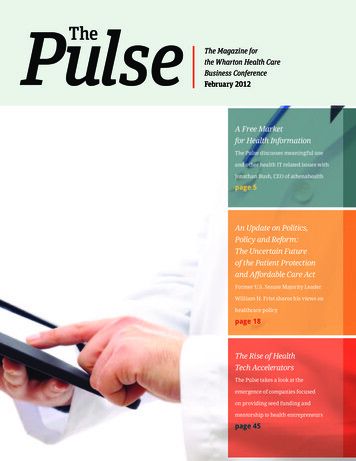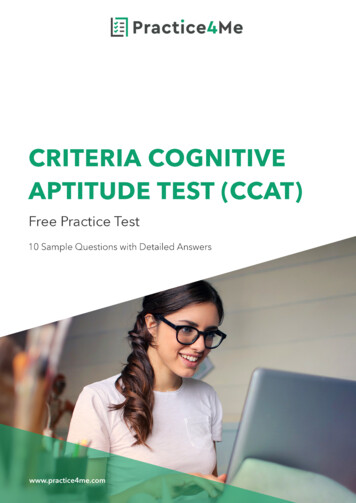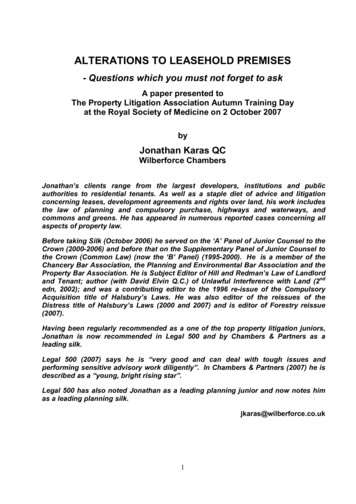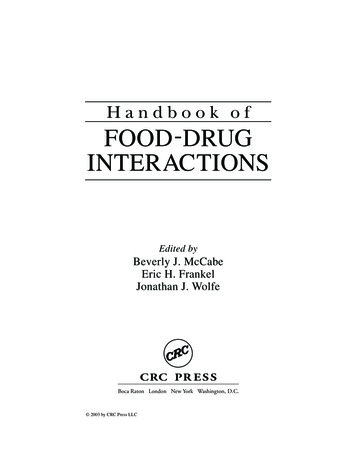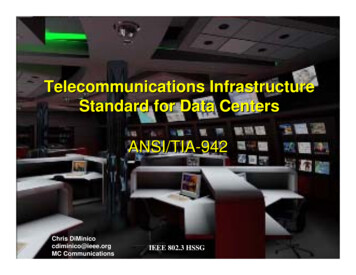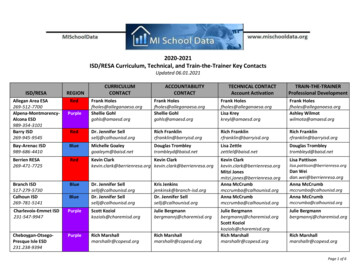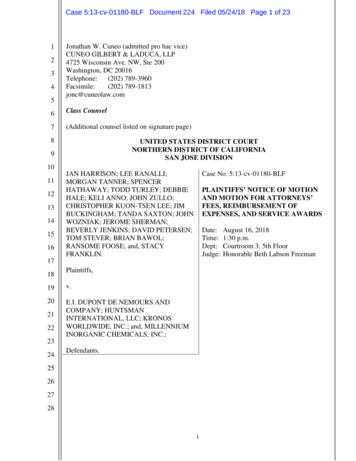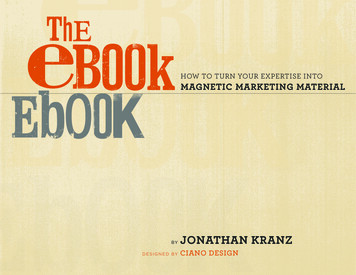
Transcription
How to turn your expertise intomagnetic marketing materialbyd e s i g n e d byJonathan KranzCiano Design
Copyright 2009 Jonathan KranzThis work is licensed under the Creative CommonsAttribution-Noncommercial-No Derivative Works3.0 United States License. To view a copy of thislicense, visit s/ or send a letter to CreativeCommons, 171 Second Street, Suite 300,San Francisco, California, 94105, USA.
e contents fIntroduction . . . . . . . . . . . . . . . . . . . . . . . . . . . . . . . . . . . . . . . . . . . . . . . . . . . . . . . . . 04Welcome to My eBook: Writing inviting introductions . . . . . . . . 24What can an ebook do for you?. . . . . . . . . . . . . . . . . . . . . . . . . . . . . . . . . . . . . . . . . . 05Case Study: Downloads of Dow Jones’Who should—and should not—create ebooks?. . . . . . . . . . . . . . . . . . . . . . . . . . . . 07Taxonomy Folksonomy Cookbook Triple Expectations. . . . . . . . . . . . . . . . . . . . 28What Will You Write About? . . . . . . . . . . . . . . . . . . . . . . . . . . . . . . . . . . . . . . 08Frame the Debate in Your Favor . . . . . . . . . . . . . . . . . . . . . . . . . . . . . . . . . . . . . . . . . 10In Conclusion: Never-ending endings. . . . . . . . . . . . . . . . . . . . . . . . . . . . 30A Matter (or Two) of Style . . . . . . . . . . . . . . . . . . . . . . . . . . . . . . . . . . . . . . . . . 32“Help, I can’t think of anything!”. . . . . . . . . . . . . . . . . . . . . . . . . . . . . . . . . . . . . . . . . 11What should your ebook sound like?. . . . . . . . . . . . . . . . . . . . . . . . . . . . . . . . . . . . . 32The Forbidden Zone: Really bad ideas for ebooks. . . . . . . . . . . . . . . . . . . . . . . . 11What should your ebook look like? . . . . . . . . . . . . . . . . . . . . . . . . . . . . . . . . . . . . . . 33Patrick Ciano’s Binding Book Design Tips. . . . . . . . . . . . . . . . . . . . . . . . . . . . . . . 34Show Your “But”: Why you need conflictand how to create it. . . . . . . . . . . . . . . . . . . . . . . . . . . . . . . . . . . . . . . . . . . . . . . . . 12So, whatever happened to St. Jacques?. . . . . . . . . . . . . . . . . . . . . . . . . . . . . . . . . . . 13Getting the Word Out: A few thoughtson promoting your ebook. . . . . . . . . . . . . . . . . . . . . . . . . . . . . . . . . . . . . . . . . . 3610 Practical Tips for Successful eBooks. . . . . . . . . . . . . . . . . . . . . . . . . . 38Organizing Your eBook Piece by Piece. . . . . . . . . . . . . . . . . . . . . . . . . . . 16Big-Picture Bites . . . . . . . . . . . . . . . . . . . . . . . . . . . . . . . . . . . . . . . . . . . . . . . . . . . . . . . . 17The Numerical List. . . . . . . . . . . . . . . . . . . . . . . . . . . . . . . . . . . . . . . . . . . . . . . . . . . . . . 18Chronological Steps. . . . . . . . . . . . . . . . . . . . . . . . . . . . . . . . . . . . . . . . . . . . . . . . . . . . . 19Expanded Case Study. . . . . . . . . . . . . . . . . . . . . . . . . . . . . . . . . . . . . . . . . . . . . . . . . . . 20Annotated Research Results. . . . . . . . . . . . . . . . . . . . . . . . . . . . . . . . . . . . . . . . . . . . . 21Little Nibbles. . . . . . . . . . . . . . . . . . . . . . . . . . . . . . . . . . . . . . . . . . . . . . . . . . . . . . . . . . . . 22Your eBook Checklist. . . . . . . . . . . . . . . . . . . . . . . . . . . . . . . . . . . . . . . . . . . . . . . 42About Jonathan Kranz. . . . . . . . . . . . . . . . . . . . . . . . . . . . . . . . . . . . . . . . . . . . . . 43About Patrick Ciano . . . . . . . . . . . . . . . . . . . . . . . . . . . . . . . . . . . . . . . . . . . . . . . . 43
4The EBOOK EBOOKYou havesomethingyourcustomersdesperatelywant.And it’s not yet another brochure.Nor is it an interrupting ad or irritating promotion.It’s your expertise. The insights, wisdomand plain, practical know-how you andyour colleagues have accumulated in thecourse of doing business. As more andmore customers and clients turn to theWeb to research important purchasingdecisions, they’re looking for genuinelyuseful information that can help themplan, work and succeed.If you’re prepared to give it the them,they’ll give you something in return:respect. You become the credibleauthority in your industry or area of business. And once you’ve captured a shareof your prospects’ minds, you’re muchbetter positioned to capture a shareof their budgets as well.
The EBOOK EBOOKWhat can an ebo o k d o fo r yo u?An ebook turns your invisible expertise into a tangible object you can placein your prospects’ hands. Here’s what it can accomplish:Lead generation: An attractive, relevant ebook is a powerful incentive to respond thatattracts qualified prospects. One of my clients turned an investment in the low fivefigures into an ebook campaign that drew 1,200 qualified leads which,in turn, led to more than 1.2 million in new business.Positive press: A great ebook gives the media something to talk about: you.ExpressPoint’s 8 Ways to Save on Freight and Fuel ebook was featured in an articleon Retail Solutions Online that became one of its top ten news stories for 2008.Expert status: An ebook tells your prospects that you’re a credible player.When St. Jacques Marketing shifted its focus to franchises, its St. Jacques BigThirty Benchmark Report of Franchise Marketers won praise from the leadingfranchise association—and positioned St. Jacques as the agency for franchisorsand franchisees.Web and social media catalyst: To date, David Meerman Scott’s ebook,The New Rules of PR, has received more than a quarter of a million downloads.The subsequent print book, The New Rules of Marketing and PR, became oneof 2007’s biggest business book bestsellers and has been translated into23 different languages.Pipeline accelerator: An ebook can be the ideal push-over piece that movesfence-sitters into action—and into the close. After sharing the 9 Noble Truthsof Customer Experience, Gomez closed deals with a number of customers theyhad been pursuing for months.5
6The EBOOK EBOOKBut yo u can’t g ive ‘em th e sam e o ld, sam e o ldA successful ebook is more collegial, reader-friendly and visually interesting than thetraditional white paper. And it is utterly devoid of the overt self-promotion of ordinarybrochures or sales sheets. Rather than communicating what you need to sell, itconnects with customers by sharing what they want to hear: information, insightsand answers they genuinely value.Frankly, many organizations just aren’t ready to write ebooks. They may not have anything to say that a customer would find worth reading. More often, they just don’t havethe imagination—or the courage—to try something new, especially something that’sfocused, not on themselves, but on their prospects and customers.Yo u’re smarter than thatIn fact, you’re probably smarter than you suspect. With ordinary writing skills and ahunger to reach new customers, you can turn your know-how into compelling content.This ebook will help you every step on the way, from identifying your subject to promoting your finished project. You’ll learn how to dig for great ideas.tell captivatingstories.organize your thoughts.and, most importantly, move readers into a deeperengagement with you and your organization.Read, learn and enjoy. And if you have any questions or comments, please feel freeto contact me directly at jonkranz@kranzcom.com.Good luck!J on at h a n K ranzKranz com
7The EBOOK EBOOKWho Should and Should NotCreate ebooksFor many organizations, writing an ebook is a great business idea; for others,it’s not so hot. No marketing tactic, no matter how powerful, is for everyone.Like any other business decision, the potential for meaningful gain should beweighed against expected (or at least suspected) costs.Ebooks are an excellent tool for companies or organizations that.KKKKEbooks may not be such a great idea for organizations that.Want to transform an “invisible” quality—such as “expertise”KKSell products or services that DON’T require customer research or deep thoughtor “intellectual capital”—into a tangible valueKKCompete primarily on price or convenience, not on quality or innovationNeed to educate suspects or prospects before they can possiblyKKDepend on impulse buys or simple commodity salesKKLack ideas or stories to tellKKWill not (or cannot) promote the finished ebookKKCannot draw upon a wealth of internal experience and expertisebecome customersKKManage long sales cycles between initial contact and signed contractsKKSpeak to multiple levels of influencers before convincing decision makersKKCan tap a deep well of internal talent and experienceKKHave a product or service that demands thoughtful consideration(and even research) on the part of potential customersKKWork within an industry hungry for new and/or high-quality informationKKSit on a wealth of intriguing customer success storiesKKWill eagerly promote the book via multiple channels: websites, email,blogs and other social media, media kits, etc.
8What WillYou WriteAbout? Identifying good contentWhat’s the easiest way to bring a noisy ebookkickoff meeting to a silent, awkward halt?Ask, “So, what’s the subject of our new book?What’s it going to be about?”Seems silly, but it’s not. After establishing a will to write an ebook, manyorganizations stumble over the way—the substance itself. At this point,a speed bump is a damned good thing: it forces you and your colleaguesto give careful consideration to your most important decision—whatshould go inside your book? Ask yourselves: What do we know that’s of real value to our prospects and customers? Where are our areas of distinctive expertise? How can we show/demonstrate/illustrate our best ideas? Who do we know (internally or externally) that can provide thecontent/material for the ebook?What lasting impression do we wish to make on readers?
The EBOOK EBOOKFi n d i n g th e g o o d stu ffGood news: The best content usually hides in plain site. Often, you’re so closeto your daily operations that you may fail to recognize the value of know-howyou take for granted. Yet that “ordinary” knowledge is frequently the insightyour prospects hunger for.Stuck for ideas? Try the following options:Solve a problemIn many sales, especially in B2B, customers make purchases to solveproblems. Can you take the sum of your experience and turn that intoa pathway for overcoming a challenge that keeps your prospects awakeat night? This approach often leads to titles such as:10 Ways to Slash IT CostsGoing Bullish in a Bear Market7 Mistakes No Accountant Should Ever MakeLead to successConversely, you can attract prospects eager to succeed. What have youlearned from previous client successes that can be distilled into a guide forothers? Think along the lines of.8 Secrets to Accelerating Time to MarketThe Step-by-Step Approach to Positive Cash FlowTurn Sluggish Sales Teams into Star Performers9
10The EBOOK EBOOKShare your researchNew information is almost always newsworthy. Is there anything you have onhand from recent market or other research that you can package into an ebook?Consider:Frame the Debate in Your FavorOvert self-promotion is a no-no. But that doesn’t mean youshould maintain a neutral posture in your content. On thecontrary, your mission is define the subject matter along linesfavorable to your strengths.Web 2.0 by 2010: What IT Planners Need to KnowRising Suns: Reaching High Net Worth Japanese ConsumersBuy, Rent or Lease? Best Commercial Real Estate Options in AtlantaLeverage your surveys, forums, workshops, etc.Many high-level executives spend a lot of time thinking about what otherexecutives might be thinking. Any access to collective opinion—gathered fromsurveys, live workshops or even online forums—will be hungrily devoured bycurious decision-makers. Can you tap your network of contacts for their opinions,then compile the results into a report?What’s Up, Doc? What Physicians Really Think about Electronic Medical RecordsFor example, if the distinguishing characteristic of your ERPsystem is easy integration with other software systems, yourebook should emphasis the value and importance of integration. If it’s scalability, talk about why it’s important to be ableto expand your systems easily and inexpensively. If it’s thedepth of service support, hammer on the significance of24/7 support for mission-critical functions.In the arena of public discourse, this is known as “framingthe debate.” Arguments are not won by logic and evidence;they’re conquered by the side that sets the context for theissue. An immigration debate, for example, is not aboutnumbers; it’s about convincing an audience that this is eitherInventory Management Forum 2009: Conference Highlightsa security issue, an economics problem, a legal concern orWho Tweeted? Technology Executives Speak Their Mindsa matter of human rights.Likewise, you want to use your ebook to frame the debate—the issue of value—in your favor. You need not (and shouldnot) mention your products or services by name. But as youcompose your content, you’re always leading the reader toconclusions—to features and benefits—that play to yourorganization’s strengths.
11The EBOOK EBOOKHelp, I can’t think of anything!The Forbidden ZoneStuck for ideas? Try this: Instead of reaching for the panicbutton, reach for a colleague. Then take a sheet of paper andcreate two columns by folding the sheet in half or drawingReally bad ideas for ebooksa line in the middle.There’s no shortage of excellent ideas for ebookcontent. But there are two truly bad ideas you shouldOne of you will take notes, the other will talk about a recentdefinitely avoid. An ebook is NOT:success story, something about how your company (or itsproducts or services) helped a client achieve its goals and/orface its challenges. As the story-teller speaks, the note-takerwill remain alert for every chunk of talent, ideas, expertise,know-how or experience the company applied that madeKKA thinly-veiled product brochureKKA place to overtly promote your brand,products or servicesthe client a success. (If the agents of success were specificIn fact, your products or services should not beproduct features, those count, too). These nuggets should befeatured at all. (Though they can be mentioned inlisted in the left column.passing.) Any copy that remotely smells like selfpromotion undermines the purpose of your project: toThen swap roles and repeat the process. Now you should haveestablish credibility and develop trust that encouragesa nice, long list on the left. Next, collaborate together on theprospects to seek out your company.right column: this is the list of things your customers want orneed; the things they hope for and the things they fear; whatthey dream of and what keeps them up at night.Once you’ve filled both columns, look for connections, thoseplaces where what-you-know intersects with what-clientsneed. Every point of intersection represents gold—a potentialtopic or sub-topic for your ebook.
12Show Your “ But ”Why you need conflict and how to create itAn ebook is a long form document that hasto hold your reader’s attention over manypages. Sustaining attention means creatingdramatic tension. And the key to dramatictension is.Conflict. Trouble. Problems.Seems counterintuitive? For those of us trained in conventional marketing think in which we’re always encouraged to accentuate the positive, embracing the darkside feels downright dangerous.Good. Because danger is what you need. Remember thisformula: Desire plus danger equals drama. I call it “3DStorytelling.” Here’s how it works:
13The EBOOK EBOOKStepIState th e DESIREWhy did the chicken cross the road? Because it wanted something on the otherside, be it shade, food or a rooster. Desire is the engine that drives a story, the forcethat gives the story its momentum. In order for a story to begin, someone has towant something.Many of the best business stories feature customers—people your prospects can empathize with. So begin there; think of a recent success you’ve had with a client. Whatobjective, goal or dream did they have? What did they want? And why did it matter?Here’s an example drawn from real life:St. Jacques, an advertising, marketing and design agency in northern New Jersey,wanted to rise above a pack of similar service providers by finding a clear, distinctivefocus. Its mission: to brand itself as THE resource for franchise marketing.Step 1Step2So, whatever happenedto St. Jacques?Yes, St. Jacques is a real business. And as you’veprobably guessed, they created an ebook. Theirswas based on a survey of marketing and salesexecutives from the leading franchise brands. Theresulting book, The St. Jacques Big Thirty Benchmark Report of Franchise Marketers proved to be thepivotal moment in their transformation into a leadingfranchise marketing agency. Here’s how it worked:1. St. Jacques commissioned a survey of franchiseexecutives to collect information that would helpthem position their agency. But the informationthey received was so rich it opened an unexpectedopportunity: a chance to share newsworthy insightswith their targeted prospects. In the words of oneArti cu late th e DANGER“Boy meets girl, boy gets girl” is not a story. “Boy meets girl, boy loses girl, boy goesthrough hell and high water, then boy gets girl” is a story. Danger—a risk, threat,impediment or obstacle—is the absolutely crucial next step in any story. Without it,there’s no friction, no emotion.To create an effective story, you must articulate the challenges that stand betweenthe hero of the story and the object of desire. In fact, the more intimidating thosechallenges are, the better.its founders, “The ebook would be a materialrepresentation of our expertise.”2. The next step involved turning the raw material of thesurvey results into a compelling and readable report.That’s where I leant a hand. Together, we groupedthe survey results into four major categories:Franchisee/Franchisor CommunicationsBrand Positioning: Consumers PLUS FranchiseesExpanding Into Areas With LittleFor St. Jacques, the danger looked like this:But St. Jacques had almost no name recognition in the franchise industry and fewfranchise contacts. Worse, it faced entrenched competition from larger agencies whohad been established in the franchise market for years. How could St. Jacques makeitself a credible presence among skeptical insiders?or No Brand AwarenessMarketing ROIFor each category, we summarized the results,presented representative participant quotes, and—most importantly—added a brief essay offeringconstructive advice on how to address each issue.
14The EBOOK EBOOKStep3D evelo p th e DRAMAOnce desire and danger have been established, you have a drama that sustainsinterest. Now all your tips, hints, secrets, suggestions, illustrations, expertise,customer quotes—all the stuff that makes up the body of your ebook—have ameaningful context: they’re the insights readers need to overcome the dangerand fulfill the desire.Just one word can make all of this so simple.This need not be complicated. In fact, you can add conflict to your ebooksimply by sticking in your “but” (or a “yet” or “however”)—a conjunction thatindicates contradiction.St. Jacques (cont.)St. Jacques aggressively promoted the book via theWeb and other channels. Favorable media attentionattracted, in turn, the interest of the leading professional association for franchisors; in fact, the agencywas invited to become part of the group’s “leadership table,” an honor that gave them intimate accessto leading franchise executives. Within a matter ofmonths, St. Jacques moved from obscurity to thetop of the franchise marketing ladder.In the introduction to this ebook, for example, I established desire by articulatingthe potential benefits of writing ebooks: establishing authority, gathering leads,gaining favorable media, etc.Then came the “but.” But if you treat the ebook as a sales piece, you’ll fail. But ifyou overtly promote your business, you’ll sacrifice credibility. But if you don’t planon promotions, you’ll won’t reach your prospects.That’s drama, which is nothing more or less than the tension between thething desired and an outcome feared—in this case, between ebook success orfailure. Readers will plow on to resolve the tension to find out how to achievethe success without succumbing to failure.Aggregate insights of 30 top franchise brand marketing professionals on theunique characteristics of marketing a franchise brandMichael and Philip St. JacquesSt. Jacques established leadership, and wonnew business, through the creation anddistribution of an impressive ebook.
The EBOOK EBOOKBeware the temptation to remain one-sided, to emphasize success with noreference to failure. Should you do so, you’ll fail to create the tension yourebook needs to sustain interest. It’s like flying a kite; staying aloft depends ontension. Should you cut the kite string, the kite does not soar—it sinks rapidlyto the ground.Here are a few examples of the “But Principle” in action, drawn from clientebooks I’ve worked on: The Internet can give you a world-wide presence, but if you can’t measure siteperformance across the globe, you’ll abandon customers you never knew about.Social media shares informal intelligence across your enterprise, but if you don’thave a formal process for capturing knowledge, that intelligence will be lost.An advance exchange model will accelerate maintenance, but only if your repairpartner has the right systems and resources in place.Placing Your “But”The introduction, the first chapter or “pre”-chapter to your ebook, is your opportunityto establish the context for the content to come. That’s why in most ebooks, as in thisone, the introduction is the place to show your “but.” Whether you literally use theconjunction is irrelevant; what matters is that you articulate the desire and thedanger at the outset.15
16OrganizingYour eBookPiece by PieceIn an age of blogs, sound bites and Twitter, howdo you make a looong document like an ebookpalatable to readers?First, keep in mind that people will read longer material—if it’s relevant to them.If it’s not, it can never be short enough.Second, you should break longer work into smaller sections. And within your sections,you can parse your content into even more digestible fragments. The advantages?Short sections are less intimidating.Ever face a New York Times article on ablurry Sunday morning? Even if the subject intrigues you, the vast sea of gray textencourages procrastination. You’ll get toit later in the week, you tell yourself—untilyou get sick of seeing the stack of papersin your kitchen and you finally chuck thewhole thing into the recycling bin. Don’t letthat happen to your ebook.Small pieces reward scanners. Busyreaders are selective, so write on theirterms. Little copy bites help readersscan for the information they want.It’s easier to write. Writing transitionsfrom idea to idea can be difficult; listssimply eliminate the transitions withoutdrawing attention to their absence.
The EBOOK EBOOKBi g-pi ctu re bitesAfter identifying the subject of your ebook, how will you organize its content?The answer shapes your high-level structure—the ebook equivalent of chaptersin a conventional book.Most ebooks have three fundamental sections:1.An introduction that establishes what the book is about and why it isbeing written.2.The body, the bulk of the book that delivers the content you promised in theintroduction.3.The conclusion, which is NOT merely a restatement of your big ideas, but serves as atransition to deeper engagement with your company/brand/organization/business.I’ll explain the introduction and conclusion later in the book. For now, let’s focus onthe body, the longest part of your ebook.You know what you don’t want: a lengthy, multipage body that flows, without relief,from beginning to end. Instead, you want to break the body into many short (often asbrief as one page) sections or chapters that follow a consistent organizing principle.These chapters typically include: A headline that identifies the subject of the chapter The body of content itself further broken down by paragraphs and/or bulleted lists Callouts or sidebars that are not part of the main content of the chapter, but offerreinforcing information of value. (I’ll get to these later in this section.)So how do you organize your content into chapters? It depends—structure is alwaysdetermined by content. You want to present your material in the most logical waythat’s easiest for readers to absorb. While you are by no means limited to the followingsuggestions, these organizational approaches represent an organic fit for most typesof commercial ebook material.17
18The EBOOK EBOOKTh e N u m eri cal ListOne of the most popular (and successful) approaches to ebook content,the numerical list, is also the simplest: you literally offer X number of ideascentered on a common theme or subject, such as: The Top Ten Ways to Save Money on Perishable Inventory Eight Things You Must Know About Probate The 5 Most Common Mistakes Investors Make Twelve Secrets to Mastering SEOReaders love the numerical list because the promise is explicit; they know exactlywhat to expect and that the book will be easy to scan. But the numbered list is abig winner for writers as well. Transitions from idea to idea are often the mostdifficult things to write. With the list, you’ve leapfrogged the problem; there areno transitions to sweat. You write the content for number one, then move on tonumber two, and so on.For example, these are the chapter headings for Gomez’s ebook, The 9 Noble Truthsof Customer Experience: Website Wisdom for Everyone in the Organization:1.Bring Everyone Into the Process2.Share Common Metrics3.Establish a Baseline4.Know Your Users5.Focus on Non-Functional Design Criteria6.Test Your Site in the Wild7.Watch Your Partners and Channels8.Build Maintainability Into the Code9.Use Tools to Build a Performance CultureyExtra CreditNotice something about Gomez’s chapter headlines?Each begins with an active verb: “bring,”“share,” “establish,” etc. These verbs energizeyour headlines while telling your readers exactlywhat to expect in the content to come.y
The EBOOK EBOOKCh ro n o lo g i cal StepsA variation of the numerical list, chronological steps organize your content withina path that readers should follow. Again, transitions aren’t necessary, but unlike thestraight list—which can be assembled or read in any order—the chronological stepsmust proceed in a precise order. For example: From Yawns to Yes: Moving Customers to the Close The Step-by-Step Plan for Executive Search Success Your Monthly Garden Planning Guide How to Launch Your eCommerce Site from Idea to ExecutionYour chapter headlines may or may not be numbered, as you wish, but should beorganized in chronological order. The Your Monthly Garden Planning Guide mighthave chapters like this: January: Design Your Garden February: Place Your Orders March: Start Your Seedlings April: Prepare Your Soil Etc.19
20The EBOOK EBOOKExpan d ed Case Stu dyAdditional sectionsCase studies combine the narrative virtues of the story (a linear beginning, middleand end) with the real-life credibility of the testimonial. By focusing on a client’ssuccess, you can introduce your product or service as a viable means to an end yourreaders can sympathize with.The ample elbow-room of the ebook allows youIn most instances, a case study need not be longer than one or two pages. But thereare times when a success story merits elaboration. Perhaps the methods or techniquesinvolved are new or complicated and need extensive explanation. Or the story involvesnot one effort, but a series of related actions over time that should be detailed. Or theconsequences of your efforts with the client were so great and multifarious that theyrequire in-depth illustration. But the best reason for expanding a case study is thatyou’ve found a story that serves as the perfect example of a larger process or programyou wish to explore.to complement the core components of thecase study with additional sections that mayinclude (but are no means limited to):KKResearch and statistics related to thecore issues in the caseKKDeep explanations of the tools/technologies/processes used in the caseKKReal-life examples from other clients/customersfacing similar issuesKKA summary of trends or conditions withinthe client’s industryWhatever the cause, the expanded case study is built on a core of threebasic components:The ChallengeThe SolutionThe ResultsHere you establish the context—who your client is, where they are, what industry they arein—and the desire: what did your client want?To trim inventory? Save on taxes? Increaserevenues? Improve profitability? Reducetransportation costs? Think of the challengeas the reason why your company was broughtinto the picture in the first place. And alwaysexplain the stakes, the “so what?” part ofthe challenge that explains why meeting orovercoming it meant something for the client.What did you actually do for the client orcustomer? The key is specificity—you wantto paint a word-picture so vivid readers canimagine themselves in your client’s shoes.Don’t skimp on meaningful details.What happened as a result of the client usingyour product or service? At this point, youshould come full circle to the desire statedin the challenge, but now, this is a thingachieved, rather than merely hoped for.Hint: when possible, get a direct quotefrom the client articulating the value yourcompany contributed.
The EBOOK EBOOKAn n otated Research Resu ltsResearch, surveys and poll results often make newsworthy raw material for outstandingebooks. But I caution against merely recycling the reports you get from your researchvendors or internal teams; while
The subsequent print book, The New Rules of Marketing and PR, became one of 2007’s biggest business book bestsellers and has been translated into 23 different languages. Pipeline accelerator: An ebook can be the ideal push-over piece that moves fence-sitters into ac
